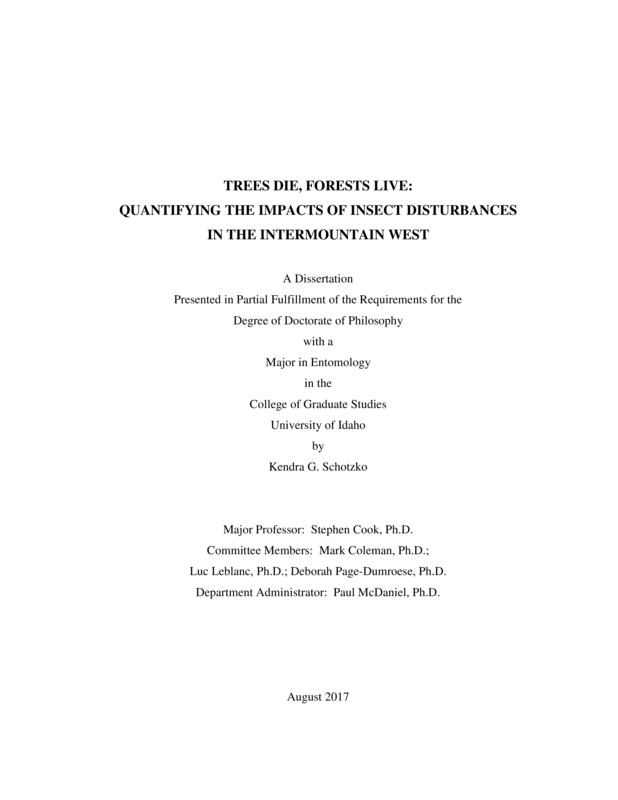TREES DIE, FORESTS LIVE: QUANTIFYING THE IMPACTS OF INSECT DISTURBANCES IN THE INTERMOUNTAIN WEST
Schotzko, Kendra. (2017-08). TREES DIE, FORESTS LIVE: QUANTIFYING THE IMPACTS OF INSECT DISTURBANCES IN THE INTERMOUNTAIN WEST. Theses and Dissertations Collection, University of Idaho Library Digital Collections. https://www.lib.uidaho.edu/digital/etd/items/schotzko_idaho_0089e_11230.html
- Title:
- TREES DIE, FORESTS LIVE: QUANTIFYING THE IMPACTS OF INSECT DISTURBANCES IN THE INTERMOUNTAIN WEST
- Author:
- Schotzko, Kendra
- Date:
- 2017-08
- Embargo Remove Date:
- 2021-03-28
- Program:
- Plant, Soil and Entomological Sciences
- Subject Category:
- Entomology
- Abstract:
-
Disturbance is often a critical aspect of forest ecosystems, and those caused by insects and disease can have a variety of effects on ecosystems. We used ground surveys to assess disturbances impacting forests within the Intermountain West. Target habitats were high elevation whitebark pine (Pinus albicaulis Engelmann) forests impacted by recent mountain pine beetle (Dendroctonus ponderosae Hopkins) outbreaks and riparian subalpine fir (Abies lasiocarpa var. lasiocarpa (Hook.) Nutt.) forests that were potentially infested with balsam woolly adelgid (Adelges piceae Ratzeburg). With regard to whitebark pine forests, the percentage of whitebark pine killed by mountain pine beetle varied widely. Overall, whitebark pine killed by mountain pine beetle had larger diameters than surviving whitebark pine. The diameter of whitebark pine killed by mountain pine beetle that were part of a tree-clump, however, were smaller than killed whitebark pine occurring as single-trunk trees, suggesting that host growth form impacts host selection by mountain pine beetle. Within these stands, subalpine fir regeneration was more dominant at lower elevations, and whitebark pine was dominant within the regeneration at higher elevations. Our surveys of riparian fir stands documented balsam woolly adelgid throughout Idaho. Infestations on subalpine and grand fir stems were positively correlated with gouting. Thinning and fading of crowns, however, were not correlated with stem infestations. Heavy stem infestations were negatively correlated with elevation for both subalpine and grand fir, which may indicate the importance of habitat or climatic factors in the expansion of balsam woolly adelgid populations.
- Description:
- doctoral, Ph.D., Plant, Soil and Entomological Sciences -- University of Idaho - College of Graduate Studies, 2017-08
- Major Professor:
- Cook, Stephen
- Defense Date:
- 2017-08
- Identifier:
- Schotzko_idaho_0089E_11230
- Type:
- Text
- Format Original:
- Format:
- application/pdf
- Rights:
- In Copyright - Educational Use Permitted. For more information, please contact University of Idaho Library Special Collections and Archives Department at libspec@uidaho.edu.
- Standardized Rights:
- http://rightsstatements.org/vocab/InC-EDU/1.0/

